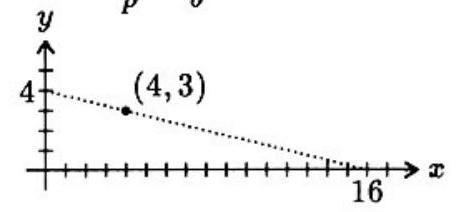Problem:
In the xy-plane, how many lines whose x-intercept is a positive prime number and whose y-intercept is a positive integer pass through the point (4,3)?
Answer Choices:
A. 0
B. 1
C. 2
D. 3
E. 4
Solution:
Write the equation of the line in the two-intercept form:
px+by=1, where p is prime and integer b>0
Substitute x=4 and y=3 to obtain
p4+b3=1 or b=p−43p=3+p−412
There are only two primes, p=5 and p=7, which yield a positive integer b. Therefore, there are two lines with the requested properties,
5x+15y=1 and 7x+7y=1
OR
Let p and b be the x- and y-intercepts of such a line. Then p>4. Since the points (p,0),(4,3) and (0,b) are collinear, by computing the slope of the line in two different ways, we find −4b−3=p−4−3, or (p−4)(b−3)=12. Thus, (p−4) must be one of 1,2,3,4,6 or 12 and p must be an odd prime. There are only two such primes, p=4+1=5 and p=4+3=7.
OR
Since both intercepts must be positive, the lines px+by=1 with the desired properties must have negative slope. Thus, the integer b is larger than 3, so b≥4. Similarly, p≥5. Draw the line from (0,4) through (4,3) to see that p≤16.
There are four primes between 4 and 16:p=5,7,11 and 13. From p4+b3=1 it follows that b=p−43p, which is an integer only when p=5 or p=7. Thus there are two such lines.
